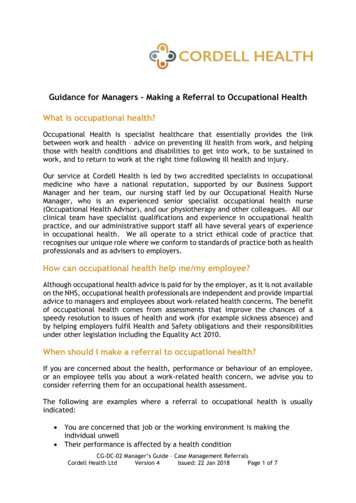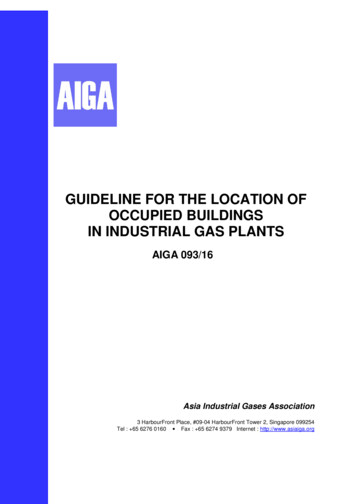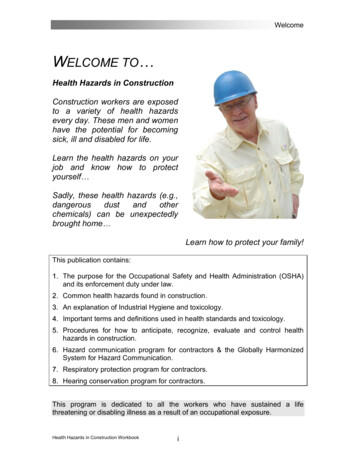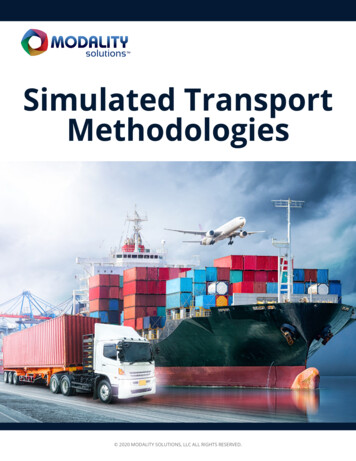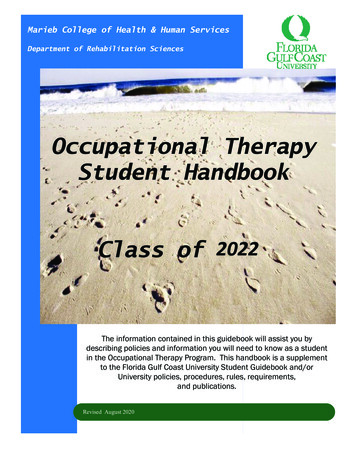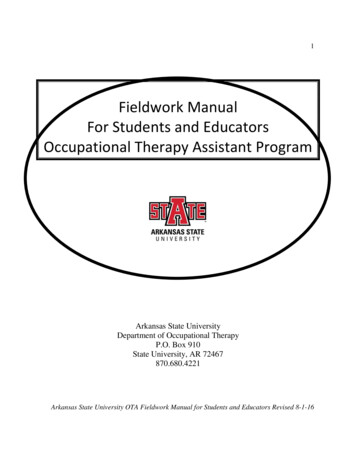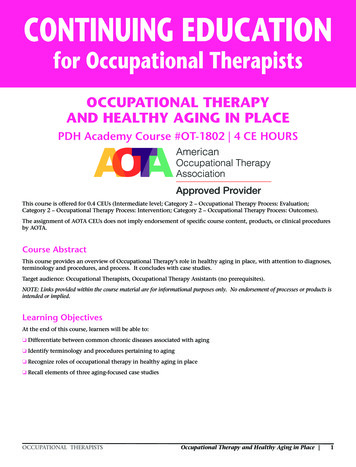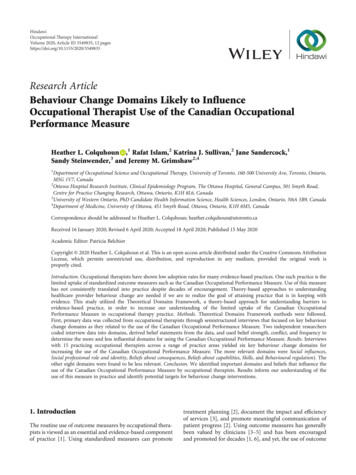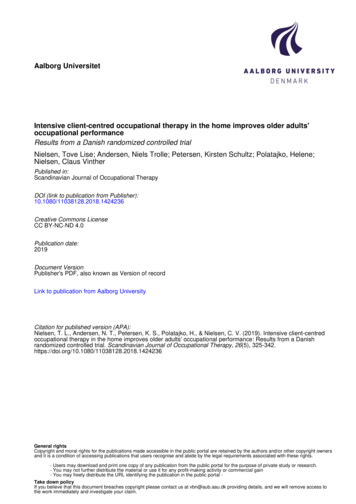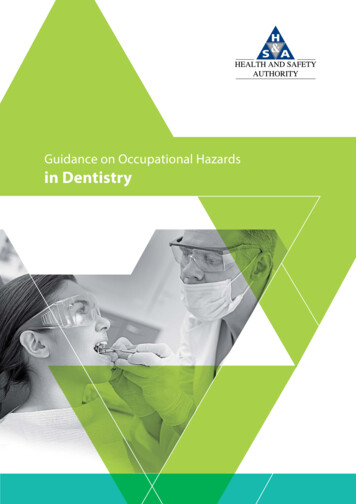
Transcription
Guidance on Occupational Hazardsin Dentistry
Our Vision healthy, safe andproductive lives
ContentsIntroduction . . . . . . . . . . . . . . . . . . . . . . . . . . . . . . . . . . . . . . . . . . . . . . . . . . . . . . . . . . . . . . . . . . . . . 2Who is at Risk? . . . . . . . . . . . . . . . . . . . . . . . . . . . . . . . . . . . . . . . . . . . . . . . . . . . . . . . . . . . . . . . . . . . 2Legislation . . . . . . . . . . . . . . . . . . . . . . . . . . . . . . . . . . . . . . . . . . . . . . . . . . . . . . . . . . . . . . . . . . . . . . . 3Hazards / Risk Management . . . . . . . . . . . . . . . . . . . . . . . . . . . . . . . . . . . . . . . . . . . . . . . . . . . . . 3Physical Hazards . . . . . . . . . . . . . . . . . . . . . . . . . . . . . . . . . . . . . . . . . . . . . . . . . . . . . . . . . . . . . . . . . 51. Musculoskeletal (i.e. posture) . . . . . . . . . . . . . . . . . . . . . . . . . . . . . . . . . . . . . . . . . . . . . . . . . 52. Radiation (Ionising) . . . . . . . . . . . . . . . . . . . . . . . . . . . . . . . . . . . . . . . . . . . . . . . . . . . . . . . . . . . 53. Radiation (Non-Ionising) . . . . . . . . . . . . . . . . . . . . . . . . . . . . . . . . . . . . . . . . . . . . . . . . . . . . . . 74. Pressure Equipment . . . . . . . . . . . . . . . . . . . . . . . . . . . . . . . . . . . . . . . . . . . . . . . . . . . . . . . . . . 9Chemical Agent Hazards . . . . . . . . . . . . . . . . . . . . . . . . . . . . . . . . . . . . . . . . . . . . . . . . . . . . . . . . 101. Anaesthetic Gases . . . . . . . . . . . . . . . . . . . . . . . . . . . . . . . . . . . . . . . . . . . . . . . . . . . . . . . . . . . 102. Amalgam . . . . . . . . . . . . . . . . . . . . . . . . . . . . . . . . . . . . . . . . . . . . . . . . . . . . . . . . . . . . . . . . . . . . 103. Acrylate and its compounds . . . . . . . . . . . . . . . . . . . . . . . . . . . . . . . . . . . . . . . . . . . . . . . . . 104. Latex . . . . . . . . . . . . . . . . . . . . . . . . . . . . . . . . . . . . . . . . . . . . . . . . . . . . . . . . . . . . . . . . . . . . . . . . 11Biological Agent Hazards . . . . . . . . . . . . . . . . . . . . . . . . . . . . . . . . . . . . . . . . . . . . . . . . . . . . . . . 12Psychosocial Hazards . . . . . . . . . . . . . . . . . . . . . . . . . . . . . . . . . . . . . . . . . . . . . . . . . . . . . . . . . . . 151. Work-related Stress . . . . . . . . . . . . . . . . . . . . . . . . . . . . . . . . . . . . . . . . . . . . . . . . . . . . . . . . . . 15Further Information . . . . . . . . . . . . . . . . . . . . . . . . . . . . . . . . . . . . . . . . . . . . . . . . . . . . . . . . . . . . . 16Published in 2016 by the Health and Safety Authority. All rights reserved.
IntroductionDental healthcare professionals (DHPs) may beexposed to a variety of workplace hazards in thecourse of performing their functions. The type anddegree of exposure is dependent upon: Type of services provided Types of service users Specific tasks performedSection 19 of the Safety, Health and Welfare at WorkAct 2005 (2005 Act) requires employers to identifythe hazards in the place of work, assess the riskspresented by those hazards and be in possession ofa written assessment of the risks to the safety, healthand welfare at work of employees. Section 20 callsfor a written Safety Statement based on the Section19 written risk assessments, specifying the mannerin which workplace health and safety will be securedand managed, including (but not limited to):Who is at Risk?Cyan 100%Magenta 76%Yellow 0Black 27%All dental healthcare professionals are potentiallyaffected, including: the dentist; auxiliary dental workers (for example nurses,therapists, hygienists, technicians); and others at the place of work (for exampleservice / maintenance personnel). The hazards identified and the risks assessed The protective and preventative measures takenThe aim of this guide is to assist in the systematicidentification of occupational hazards in dentistry andto highlight protective and preventative measuresthat might be adopted in order to mitigate the risksposed to workers to as low a level as reasonablypracticable.2Health and Safety Authority Guidance on Occupational Hazards in Dentistry
Hazards/Risk ManagementCyan 100%Magenta 76%Yellow 0Black 27%LegislationFor the purpose of this guide, the most relevanthealth and safety legislation, codes of practice andstandards are: The Safety, Health and Welfare at Work Act2005 (S.I. No. 10 of 2005) The Safety, Health and Welfare at Work (GeneralApplication) Regulations 2007 to 2016 Amendments to the Safety, Health and Welfare atWork (General Application) Regulations 2007to 2016, in particular “Control of Artificial OpticalRadiation at Work” and “Pressure Systems” The Safety, Health and Welfare at Work (ChemicalAgents) Regulations 2001 (S.I. No. 619 of 2001),particularly Regulations 4 &Welfare at Work (Chemical Agents) Regulations2001 (as amended) 2013 Code of Practice for the Safety, Health andWelfare at Work (Biological Agents) Regulations2013 Dental Council Code of Practice “InfectionPrevention and Control” 2015Relevant Standards ISO 7494-1:2011 Dental Units: Generalrequirements and test units. ISO 4073:2009 Location of dental equipment in theworking area of the oral healthcare provider.Hazards / Risk ManagementWith respect to the 2005 Act requirement to secureand manage workplace health and safety, Annex C ofI.S. OHSAS 18002:2008 divides occupational hazardsinto 4 categories:1. Physical2. Chemical3. Biological4. Psychosocial The Safety, Health and Welfare at Work (BiologicalAgents) Regulations 2013 (S.I. 572 of 2013) European Union (Prevention of Sharps Injuries inthe Healthcare Sector) Regulations 2014 (S.I. 135 of2014) EC (Carriage of Dangerous Goods by Road and Useof Transportable Pressure Equipment) Regulations2011 to 2015 as may be amended from time totimeRelevant Codes of Practice Related to Health andSafety LegislationHazard identification should aim to determineproactively all sources, situations or acts (or acombination of these) arising from an organisation’sactivities. Therefore the hazard identificationprocesses should be applied to the following: all non-routine as well as routine activities (forexample periodic, occasional and emergency); all persons having access to the workplace (forexample patients, visitors, contractors, deliverypersonnel,); human behaviour, capabilities and other humanfactors; 2016 Code of Practice for the Safety, Health andHealth and Safety Authority Guidance on Occupational Hazards in Dentistry3
Hazards/Risk Management infrastructure, equipment and materials at theworkplace (whether provided by the organisationor others); and the design of work areas, processes and operatingprocedures and their adaptation to humancapabilities.Cyan 100%Magenta 76%Yellow 0Black 27%Other hazards which may be relevant in a dentalpractice but are not included in this guide are listedbelow (non-exhaustive list). Information on thesehazards is available on the Health and Safety Authoritywebsite at www.hsa.ie. ElectricityFor the purpose of this guide, routine dentalactivities that may present a risk to dental healthcareprofessionals are discussed. These are listed below(readers are reminded that this is a non-exhaustivelist): Slips/trips/falls1. Physical hazards: Workplace vehicles / driving for worka) Musculoskeletal (i.e. posture) Radonb) Ionising radiation Noisec) Non-ionising radiation Work-related violence and aggressiond) Pressure systems Bullying at work Display screen equipment Fire Patient handling2. Chemical hazards:a) Anaestheticsb) Amalgamc) Acrylate and its compoundsd) General compressed gasese) Latex3. Biological hazards:a) Blood/saliva/tooth fragmentsb) Sharpsc) Healthcare risk wasted) Legionella bacteria4. Psychosocial hazards:a) Work-related stress4Health and Safety Authority Guidance on Occupational Hazards in Dentistry
Physical HazardsCyan 100%Magenta 76%Yellow 0Black 27%Physical HazardsAdministrative controls1. Musculoskeletal (i.e. posture) Adjustment of the workstation to the patient eachDuring dentistry procedures, the dentist’s postureis strained, which induces stress injury on themusculoskeletal system. This occurs in 37.7% of worktime (Ayatollahi, 2012).The main factors associated with any task riskassessment are: Static positions that may be required (definedas “working posture maintained longer thanfour seconds; this applies to slight or non-existentvariations around a fixed force level, delivered bymuscles and other body structures) Duration of task Awkward postures for dental personnel Tasks requiring:o extended reach;o bent or twisted necks; oro abducted arms (drawing out to the side).Control strategies to mitigate the risk associated withsuch ergonomic hazards include:Engineering controls Good ergonomic design of workstation, chairs,instruments and equipment, for example, seeParagraph 4.31 of HBN 12 Supplement 2: Designimplications of Oral Surgeries (National HealthService Estates) and ISO standards listed inthe bibliography of ISO 4073:2009 (InternationalStandards Organisation, 2009) Use of automatic and ultrasonic instruments / toolswhenever possible Use of indirect vision when treating maxillary teeth Minimisation of glare through the use ofappropriate lighting and window coveringsHealth and Safety Authority Guidance on Occupational Hazards in Dentistrytime Scheduling of patients in an effort to reduce riskfactors Training regarding ergonomic hazards and controlstrategies Early reporting system to capture symptoms ofergonomic concerns Alternating working posture frequently andperforming stretches during any micro-breaks Including ergonomic considerations in allworkstation/work equipment procurementpolicies Maintenance of all work equipment as permanufacturer’s recommendations2. Radiation (Ionising)According to the former Radiological ProtectionInstitute of Ireland (RPII 1996), the largest singlecontributor of man-made radiation exposure to thepopulation is medical and dental diagnostic radiology.Dental radiology can give rise to a significant dose ofradiation to the bone marrow in the skull and cervicalspine, the oral mucosa, the thyroid and the eye.The implications of regulation in this area for dentalpractices are: a licence must be obtained from theEnvironmental Protection Agency (formerly RPII); all radiological exposures shall be clinically justified(procedures that minimise the dose to patientsand at the same time yield the required diagnosticinformation must be utilised); a named dentist in each practice referred toas the Radiation Protection Officer (RPO), whois appropriately trained (as approved by theDental Council), is required to take on the day-to-5
Physical Hazardsday responsibility for radiological protection; all x-ray units must be commissioned by anapproved *Radiation Protection Advisor (RPA), priorto first being used on patients; all x-ray units shall be maintained and serviced bya suitably qualified and competent person (recordsmust be kept); a Quality Assurance (QA) assessment must becarried out on all x-ray units by the appointed RPAevery two years; it is essential that meticulous attention be givento processing techniques (in order that repeat x-rayexaminations are not necessary);Cyan 100%Magenta 76%Yellow 0Black 27% operators should stand at a distance of at least 2metres from the patient’s head during exposureand out of the direct line of the beam; special attention should be applied to theprotection of women of childbearing age andpregnant women; and personal dosimetry is required unless a riskassessment performed by an *RPA in conjunctionwith the dentist indicates that operators are notexpected to receive doses in excess of 1.0 mSv/year. The risk assessment carried out by the RPA shallestimate all expected staff doses, taking account ofthe following:o identification of people at risk,o realistic workload,o type of X-ray unit,o radiation output,o types of scans performed,o layout of surgery,o operator position,o the likelihood of recording a reportabledose, ando previous dose records for the staffperforming similar work.*RPA Category 1 (for Dentistry) is defined asan advisor holding a degree or equivalent in aphysical science, or a suitable combination of otherqualifications and experience. In addition, trainingin a programme based on the topics of the basicsyllabus is required. A category 1 RPA needs theequivalent of seven years’ full-time experience in apost directly concerned with radiation protectionpractice. The EPA maintains a register of allapproved RPAs on its website (www.epa.ie).6Health and Safety Authority Guidance on Occupational Hazards in Dentistry
Physical HazardsCyan 100%Magenta 76%Yellow 0Black 27% Where handheld x-ray units are used, advice Replacement of older x-ray equipment with newershould be sought from the RPA regarding:o equipment selection,o review of current risk assessment andoperation of ‘dynamic risk assessments’ foreach use,o review of personal dosimetry arrangements,ando security arrangements against loss or theft.A study conducted among Canadian dentistsconcluded that direct radiation injury has virtuallybeen eliminated by improvements in radiologicequipment / methods and radioprotection measures(Gambhir, 2011).Control strategies to mitigate the risk associated withsuch radiation hazards include:Engineering controlsequipment (with additional safety features).Administrative controls Radiation safety programmeStaff trainingProcedures to reduce exposure timeExposure monitoring (where required)Periodic review by RPA, particularly if changesmade Periodic test and examination of equipment Appropriately word “Radiation” warning signsposted on access doors Multilingual / Pictorial pregnancy signs in waitingor other appropriate areasProtective equipment controls Lead aprons (for persons holding or supportingpatients during a dental x-ray) and thyroid shields(for patients where the thyroid will be exposed) Good workplace design:o room location and structural design(including shielding, screens, occupancy ofadjoining rooms including above andbelow),o room size and positioning of equipment,o clearly defining the 2m control area frompatient’s head, ando radiation warning lights positioned at accessdoors, which illuminate during exposure. Good workplace equipment design:o certificates of conformity and CE-marking,o interlock systems,o minimal scatter,3. Radiation (Non-Ionising)Non-ionising radiation has become an importantconcern with the use of blue light and to cure variousdental materials (for example composites and otherresins) (Gambhir, 2011).The Health and Safety Authority guidance documententitled “Guidance for Employers on Control of ArtificialOptical Radiation at Work Regulations 2010” givespractical assistance for the prevention of occupationalaccidents and ill health associated with sources ofartificial optical radiation. Medical treatments (forinstance laser surgery and blue light therapy) arelisted as work activities that generate hazardous levelsof intense light in Annex B of the Guide.o correct positioning of devices, ando audible signal when exposure is ended.Health and Safety Authority Guidance on Occupational Hazards in Dentistry7
Physical HazardsCyan 100%Magenta 76%Yellow 0Black 27%Lasers:LED (Blue Light)The main clinical applications of lasers in dentistry are:Curing light has become an integral part of thedaily practice of restorative dentistry. In this regard,visible light-cured resin-based composites are thepredominant restorative materials for both anteriorand posterior restorations (Singh, 2011). Halogenlights and LED units are by far the most frequentlyused in daily practice. Soft tissue and periodontal surgeryRoot canal treatmentDesensitisationAnalgesiaEndodonticsTooth bleaching Tooth cavity preparationThe main occupational hazards associated with theuse of lasers are: Eye damage Skin damage FireFrom an occupational safety perspective, the bluelight used to cure composite is not well tolerated bythe human eye (i.e. solar retinitis).Control strategies to mitigate the risks associated withexposure to LED (blue light) hazards include: Smoke inhalation (cellular and viral debris)The main control strategies to mitigate the riskassociated with exposure to laser beam hazardsinclude:Engineering controls Good workplace design:oensure no reflective surfaces,olocal exhaust ventilation,ofail-safe systems, andolock/key access for activation.Administrative controls good workplace design (covering curing site), and laser safety programme, blue light filters. staff training, and restricted work area.Protective equipment controls gloves, gown, and appropriate eye-protection.8Engineering controlsAdministrative controls staff training, equipment maintenance as per manufacturer’sguidelines, and restricted work area.Health and Safety Authority Guidance on Occupational Hazards in Dentistry
Physical HazardsCyan 100%Magenta 76%Yellow 0Black 27%Protective equipment controlsControl measures to mitigate such risks include: eye protection to light in the blue wavelength. determine the type of equipment (for example4. Pressure Equipmentsize, operating pressure, pressurising medium) andcontrol system (manual or automated);Typical pressure equipment used in dentistryincludes: assess the risk of door opening violently, under compressed gas cylinders, verifying “Nil” pressure before opening door; autoclaves, and location; compressed air systems (fixed and portable). operator training and instruction;The failure of pressure equipment can result in seriousinjuries to staff/patients and cause major damage tostructure / property. The control measures to preventsuch failures relate to the mechanical integrity of theequipment involved. thorough examination of pressure equipmentCompressed gas cylinders:The main control strategies to mitigate the risksassociated with compressed gas cylinder hazardsinclude: store as per manufacturer / supplierrecommendations (for instance upright, secured inplace, well ventilated and appropriate area); ensure labelling is as per manufacturer’srecommendations; and all staff involved in delivery, connection anddisposal of cylinders must be trained andcompetent.Autoclaves:The most serious risks associated with autoclavescome from the uncontrolled release of stored energy(for example inadvertent opening or failure of doormechanism while under pressure). Others include: scalding, andpressure;as per Schedule 12 Part B of the Safety, Health andWelfare at Work (General Application) Regulations2007 to 2016, at the following frequency:o 14 months for self-generating autoclaves;ando 26 months for all other autoclaves; maintenance and inspection (as per manufacturer’srecommendations and undertaken by competentperson).Compressed air systemsThe most serious risks associated with air receiverscome from the uncontrolled release of stored energy(for example catastrophic failure of vessel whilst underpressure).Control measures to mitigate such risks include: thorough examination of air receivers (every 26months as per Schedule 12 Part B of the Safety,Health and Welfare at Work (General Application)Regulations 2007 to 2016; and maintenance and inspection (as permanufacturer’s recommendations and undertakenby competent person). explosion of sealed glass containers containingliquids.Health and Safety Authority Guidance on Occupational Hazards in Dentistry9
Chemical Agent HazardsChemical Agent HazardsDental medicaments and materials, as well asdisinfectants used in dental surgeries, can causeallergies and skin diseases. Dentists are at risk ofoccupational exposure to a variety of chemicals suchas anaesthetic gases, amalgam, acrylates, latex anddisinfectants.Cyan 100%Magenta 76%Yellow 0Black 27%ventilated and away from any form of heat (radiator,autoclave and sunlight, for example). The work surfaceshould be smooth and impervious. leaks in breathing circuits and face masks.Waste dental amalgam is considered to be hazardouswaste. The holder of the waste must have theamalgam waste collected and treated by a companylicensed to handle this type of waste. Amalgamcapsules, waste amalgam, amalgam sludge and usedamalgam filters on suction units as well as extractedteeth with amalgam fillings must be segregatedfrom other waste, stored in special UN-approved,labelled containers with vapour suppressant. Dispatchdocumentation for hazardous waste (including wastetransfer forms, hazardous waste transport documentsand tagging records) must be completed correctlyand records kept by the waste generator.The main controls are:3. Acrylate and its Compounds Scavenging systemDental polymer materials based on Methacrylate,used as a filler, seem to be a major cause of contactdermatitis in dental personnel and also a cause ofoccupational asthma (Singh, 2011).1. Anaesthetic GasesIn dentistry, a mixture of nitrous oxide (N2O andoxygen (O2) is used in inhalation analgesia for painrelief and anxiety reduction. The main sources ofexposure to dental healthcare professionals are from: the patient’s exhaled breath, and Room ventilation Maintenance of equipment Routine air monitoringFor more information, see the HSA information sheet“Controlling Waste Anaesthetic Gases in HealthcareSettings” September 2014, available at www.hsa.ie.Control strategies to mitigate the risks associated withsuch exposures include:Engineering controls where possible, substitution with less harmful2. AmalgamMost amalgams are now supplied in disposablecapsules containing pre-measured amounts ofmercury and other metal alloys, separated by adiaphragm.All those involved with the handling of mercury inany form should understand its potential hazards andreceive training in safe handling procedures to dealwith mercury spills, including the safe disposal ofcontaminated materials.The area where amalgam is prepared should be well10product, maintain adequate general ventilation, enclosed mixing devices, and local exhaust ventilation.Administrative controls develop safe work procedures, maintain good hygiene practices, staff training, and occupational health monitoring.Health and Safety Authority Guidance on Occupational Hazards in Dentistry
Chemical Agent HazardsCyan 100%Magenta 76%Yellow 0Black 27%Protective equipment controls aseptic non-touch techniques (ANTT), gloves, eye-protection, and respirators, if risk assessment specifies.4) LatexAccording to (Singh, 2011), latex allergy was reportedin 9% of dental personnel in a dental school inAustralia. Latex gloves and masks have been wornroutinely in the dental profession for more thantwo decades and are the basis of good infectionprevention and control strategies. using low-protein (hypoallergenic), powder-freegloves is unlikely to lead to new cases of latexallergy; individuals with existing latex allergy shouldcontinue to take latex-avoidance measures; and the health of individuals with existing latex allergyis not put at significant risk if colleagues usepowder-free and hypoallergenic latex gloves.For further information, see HSA guidance“Dermal Exposure Information Sheet 2010” and“The Prevention of Glove-related Latex Allergy inHealthcare Workers” at www.hsa.ie.Natural rubber latex (NRL) can cause asthma anddermatitis. Latex is used in medical gloves, but is alsofound in medical products (for example rubber damequipment, elasticised bandages, dressings)NHS plus Occupational Health Clinic EffectivenessUnit Report (Royal College of Physicians, 2008),concluded:Health and Safety Authority Guidance on Occupational Hazards in Dentistry11
Biological Agent HazardsBiological Agent HazardsDentists may be exposed to a variety of microorganisms via blood or oral / respiratory secretions.Examples of such micro-organisms are: viruses, such as hepatitis B and C, Herpes Simplexvirus types 1 and 2, HIV and cytomegalovirus; and bacteria, such as mycobacterium tuberculosis.Possible sources of exposure to biological agents fordental healthcare professionals include: contact with contaminated sharps and healthcarewaste; respiratory infectious disease through splattersfrom bodily fluids and/or projectiles while usinghigh-speed rotary handpieces; respiratory infectious disease through airbornetransmission; and environmental biological contaminants fromwater/ventilation systems (for example legionella).According to the Dental Council of Ireland, 2015,exposure-prone procedures (EPPs) include situationswhere the worker’s hands (whether gloved or not)12Cyan 100%Magenta 76%Yellow 0Black 27%may be in contact with sharp instruments, needletips or sharp tissues (spicules of bone or teeth) insidea patient’s open body cavity, wound or confinedanatomical space where the hands or finger tipsmay not be completely visible at all times. There isan increased risk of transmitting blood-borne virusesbetween DHPs and patients during EPPs.Standard precautions relating to infection preventionand control are based on the principle that all bloodand body fluids, including secretions and excretions(except sweat), are potentially infectious. Theobjective of standard precautions is to break the chainof infection. Dental practices should have formal,written infection prevention and control policies,which are site-specific and are in line with standardprecautions and national best practices.The Dental Council Code of Practice relating toInfection Control, 2015, sets out the standardsrequired to minimise the risk of infection to patientsand dental healthcare professionals alike. The DentalCouncil requires dental healthcare professionals toadhere to this code of practice.Health and Safety Authority Guidance on Occupational Hazards in Dentistry
Biological Agent HazardsCyan 100%Magenta 76%Yellow 0Black 27%Control measures to reduce the risk of exposureinclude the following: Undertake a written risk assessment as perRegulation 7 of the Safety, Health and Welfareat Work (Biological Agents) Regulations 2013 andRegulation 4 of the EU (Prevention of SharpsInjuries in the Healthcare Sector) Regulations 2014(Sharps Regulations) Provide training to all DHPs in infection preventionand control procedures. Training should equip staffto understand:o safe injection practices,o respiratory hygiene and cough etiquette,o management of waste,o management of laundry,o decontamination of reusable medicalequipment, ando decontamination of the environment.o potential risks to health,Adherence to transmission-based precautions,in addition to standard precautions, may also berequired in certain circumstances.o how infections are transmitted, andprecautions to reduce exposure, Adherence to safe work practices and procedureso the practice policy on decontamination andinfection prevention and control,o what personal protection is required andwhen to use it, ando what to do in the event of accidents orpersonal injury. Adherence to standard precautions by Dentalhealthcare professionals at all times in healthcaresettings. The elements of standard precautions are:o occupational health programme (includingimmunisation and screening),in keeping with the requirements of the sharpsregulations. Where there is a risk of a sharps injury,controls include:othe elimination of unnecessary use ofsharps, in so far as it is reasonablypracticable and where sharps cannot beeliminated,othe use of appropriate, safety-engineeredprotection mechanisms (i.e. the use of safersharps) where they are available andappropriate,o prevention of re-capping needles,o hand hygiene,o procedures and arrangements for the safeuse and disposal of used sharps,o use of personal protective equipment (forexample gloves, eye protection, face masks,gowns),o the use of personal protective equipment(disposable gloves),o management of spills of blood and bodilyfluids,o appropriate patient placement,o management of sharps,o vaccination of employees,o information, training and awareness-raisingwith employees, ando reporting of incidents, response and followup.o management of needle-stick injuries,Health and Safety Authority Guidance on Occupational Hazards in Dentistry13
Biological Agent Hazards Dental Unit Water Lines (DUWLs):oDental Unit Water Lines (DUWLs) are proneto microbial contamination, build-up ofbiofilm and are a potential source oflegionellosis (Dental Council of Ireland,2015). Currently there is no microbial limitvalue set for dental unit output water inIreland or the EU. The EU’s potable drinkingwater standard of 100 cfu/ml should beadhered to as a minimumoThe manufacturer’s instructions should befollowed for the periodic disinfection ofwater lines. Regular disinfecting with achemical agent is the most effectiveapproach. Management of waste:14ofor
Health and afety Authority Guidance on Occupational Hazards in Dentistry 5 Cyan 1 Magenta e llo 0 Black 2 Physical Hazards Physical Hazards 1. Musculoskeletal (i.e. posture) During dentistry procedures, the dentist's posture is strained, which induces stress injury on the musculoskeletal system . This occurs in 37 .7% of work time (Ayatollahi .
